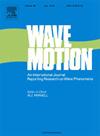Investigating Rayleigh wave anisotropy in faulted media with three-component beamforming: Insights from numerical models and applications for geothermal exploration
IF 2.5
3区 物理与天体物理
Q2 ACOUSTICS
引用次数: 0
Abstract
Rayleigh waves are prevalent in the ambient seismic noise wavefield and are thus often exploited in passive seismic methods to characterise the near subsurface. In fractured or faulted media, Rayleigh waves show anisotropic velocities that could provide information on the fault properties. However, the exact relationship between Rayleigh wave anisotropy and true anisotropic structures is not well known. This study used a three-component (3C) beamforming toolbox to analyse numerical full waveform seismic wave propagation from conceptual models of fractured media, which depict the nonlinear physical behaviour of the wave. We identify Rayleigh waves in the synthetic data produced from a single point source at different locations, compare observed Rayleigh wave anisotropy to structural anisotropy, and assess the effect array design and source distance have on Rayleigh wave analysis and observed anisotropy. Numerical analysis shows that the smaller the velocity contrast between fault and surrounding rock, the more complex the anisotropic response. We find that the slow directions of Rayleigh wave propagation can be a better indicator of fault strike than the fastest direction, when the velocity contrast between the two media is small.
利用三分量波束形成研究断层介质中的瑞利波各向异性:来自数值模型的见解及其在地热勘探中的应用
瑞利波在环境地震噪声波场中很普遍,因此经常在被动地震方法中利用瑞利波来表征近地下。在断裂或断层介质中,瑞利波显示出各向异性的速度,可以提供断层性质的信息。然而,瑞利波各向异性与真正的各向异性结构之间的确切关系尚不清楚。本研究使用三分量(3C)波束形成工具箱,从裂缝介质的概念模型中分析数值全波形地震波传播,该模型描述了波的非线性物理行为。在不同位置的单点源合成数据中识别瑞利波,比较观测到的瑞利波各向异性和结构各向异性,评估阵列设计和震源距离对瑞利波分析和观测到的各向异性的影响。数值分析表明,断层与围岩速度差越小,各向异性响应越复杂。我们发现,当两种介质之间的速度差较小时,瑞利波传播的慢方向比最快方向能更好地指示断层走向。
本文章由计算机程序翻译,如有差异,请以英文原文为准。
求助全文
约1分钟内获得全文
求助全文
来源期刊

Wave Motion
物理-力学
CiteScore
4.10
自引率
8.30%
发文量
118
审稿时长
3 months
期刊介绍:
Wave Motion is devoted to the cross fertilization of ideas, and to stimulating interaction between workers in various research areas in which wave propagation phenomena play a dominant role. The description and analysis of wave propagation phenomena provides a unifying thread connecting diverse areas of engineering and the physical sciences such as acoustics, optics, geophysics, seismology, electromagnetic theory, solid and fluid mechanics.
The journal publishes papers on analytical, numerical and experimental methods. Papers that address fundamentally new topics in wave phenomena or develop wave propagation methods for solving direct and inverse problems are of interest to the journal.
 求助内容:
求助内容: 应助结果提醒方式:
应助结果提醒方式:


